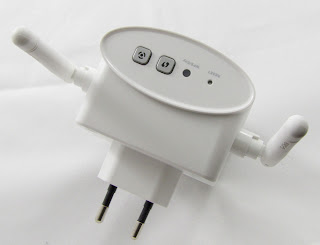Today we also have Power over Ethernet (POE) in the home. We have seen technology from both Netgear and D-Link for the home local area networks. Most IT manufacturers make this gear
When we opened the box we found two POE adapters and two standard Ethernet cables. We connected one adapter to the wireless router in our home and the second adapter to the power outlet in one of my son's room.
Each adapter should have its own power outlet for the best possible performance. That means means you don't want to connect one of these adapters to a power outlet strip.
D-Link DHP-307AV
Both D-Link and Negear claim these adapters can reach line speeds of 200 mbs in your home. This in the speed of the POE local area network (LAN).
Internet Wide Area Network speeds (WAN) speeds are almost always slower. For example, the Brighthouse Road Runner Networks offer 30 mbs speeds to the Internet also know as "the cloud."
In our testing we got between 14-15 mbs download and a 3-5 mbs upload speeds to the Internet. On a wireless Internet connection with Speedstest the speeds were 5 and 3 mbs respectively. The upload speed is the important in most cases.
Be aware that some homes there are on two or more separate power zones. This means if you router in Zone A, and the remote POE adapter in Zone B of your home, POE devices will be unable to communicate.
The D-Link device has three lights on it: power, the home wiring and a LAN light. All three should be green on both ends.
Since you can move the POE adapter and cable to wherever you may need it, this technology offers a higher speed option to wireless.
The POE adapters are considered layer 2 (L2) of the OSI model and uses bridging technology which is similar to a switch. This means that as you add more nodes (POE adapters) to your network, overall network performance is less likely to diminish.
It also means that you can use the POE adapter to transmit Internet media to a Netflix Roku streaming media player.
Likewise, D-Link makes an 802.11N wireless adapter. If you have a dead spot in you home, you can plug this into the wall to extend a wireless network.
The POE adapters are considered layer 2 (L2) of the OSI model and uses bridging technology which is similar to a switch. This means that as you add more nodes (POE adapters) to your network, overall network performance is less likely to diminish.
It also means that you can use the POE adapter to transmit Internet media to a Netflix Roku streaming media player.
Likewise, D-Link makes an 802.11N wireless adapter. If you have a dead spot in you home, you can plug this into the wall to extend a wireless network.
D-LINK DHP-W306AV PowerLine AV Wireless Extender DHP-W3
This POE technology is compliant with the HomePlug AV standard.
Rightardia by Rightard Whitey of Rightardia is licensed under a Creative Commons Attribution 3.0 Unported License.
Permissions beyond the scope of this license may be available at rightardia@gmail.com.


No comments:
Post a Comment